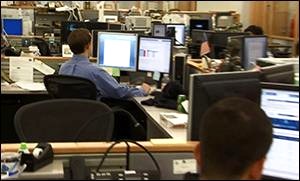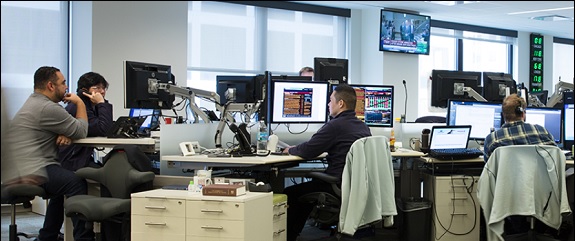The New York Fed Has Quietly Staffed Up a Second Trading Floor Near the S&P 500 Futures Market in Chicago
By Pam Martens and Russ Martens: January 31, 2022 ~

Trading Floor at the New York Fed in Lower Manhattan (Obtained by Wall Street On Parade from a Fed Educational Video)
On January 11, Simon & Schuster released a new book on the Fed. It’s written by bestselling author and business reporter, Christopher Leonard. The title leaves little doubt about what the author has set out to prove: The Lords of Easy Money: How the Federal Reserve Broke the American Economy.
For those of us who have been scrutinizing the trading operations of the New York Fed for decades, with the appropriate amount of skepticism that is inexplicably missing among the mainstream press, Leonard delivers a bombshell on page 242. Leonard writes:
“The conference room in the New York Fed was located just off the main trading floor, and its doors were open during meetings so people could quietly go in and out. The room was anchored by a large table, with a couch along the wall for staffers to sit with their laptops open and take notes. There was a set of large digital monitors hanging on one wall, one of which provided a live video feed from an eerily identical room in Chicago, in a Fed satellite office near the important Chicago Mercantile Exchange.”
What Leonard is describing is the Markets Group at the New York Fed, the only one of 12 regional Federal Reserve Banks to have its own trading floor; its own traders with Bloomberg terminals; its own speed dials to the major investment banks on Wall Street; and its own analysts that ferret out market-moving information from around the globe on a continuous basis. (Leonard was given an official tour of this area at the New York Fed on February 27, 2020, according to the “Notes” section of his book.)
What Leonard is suggesting on page 242 is that the New York Fed’s trading floor is no longer just content to sit close to the New York Stock Exchange in lower Manhattan. The New York Fed’s Markets Group has decided to clone itself with another trading floor that sits close to the Chicago Mercantile Exchange where S&P 500 futures are traded, as well as other futures contracts.
Why is that a bombshell? Because it suggests to Wall Street savvy readers that the New York Fed may be planning to use the futures markets to try to engineer a soft landing in an attempt to get itself out of the very serious mess it’s made that Leonard explains very convincingly throughout his book.
We checked out the New York Fed’s website and found no mention of this satellite trading floor and satellite Markets Group in Chicago. The Chicago Fed is not so secretive, however, and confirms on its website that the New York Fed’s satellite office is located inside its building. The Chicago Fed actually lists profiles of six staffers at the New York Fed’s facility, but it uses only first names, as if these folks are in some kind of witness protection program.
There are currently nine help-wanted ads listed online for the New York Fed’s satellite office in Chicago. The most interesting is for a “Contact Engagement Policy Advisor.” That job includes this description: “Proactively identify, build, and maintain relationships with a diverse set of senior external market participants, including to develop contacts in new areas or markets where additional relationships are needed; support stakeholders and other senior management develop and maintain their contact networks.”
For how the New York Fed has engaged in market intelligence gathering in the past, see this informational video by Karin Kimbrough, a former Assistant V.P. at the New York Fed.
On pages 113-114 of his book, Leonard describes what the trading floor at the New York Fed looks like. (For photos of what the New York Fed’s trading floor has looked like through the years, see our article from 2013. For the names of the Wall Street megabanks that, literally, own the New York Fed and its money button that endlessly bails them out with trillions of dollars produced at the flick of an electronic switch, see our article from 2019.)
Leonard sums up his description of the traders and their trading floor at the New York Fed with this: “They are the only traders in the world who can buy things by creating new dollars. This is the basis of the Fed’s ability to influence the economy and the banking system.”
Well, now these New York Fed traders have clones of themselves — magically creating money at the push of a button in Chicago.
Creating this cloned facility in Chicago has apparently been going on for a number of years. One individual reports at Glassdoor that he interviewed for the job of Policy and Markets Analysis Associate at the New York Fed’s office in Chicago in December 2017. He said the process took five weeks and he didn’t get a job offer. He writes this: “Was flown in for interviews: 3 interviews (30 mins each) with two people at a time. First one was behavioral, second was econ heavy, third was more questions directly about the fed. In the afternoon, took a policy writing test (90 minutes).” One of the interview questions he was asked was: “What did the Fed do during the 2008 crisis.” If he correctly answered that it bailed out the Wall Street banks and their foreign derivative counterparties to the tune of $29 trillion – the very banks that created the crisis — that might be why he didn’t get the job. If he had adopted former Fed Chairman Ben Bernanke’s position – that he and the Fed had the “courage to act,” he would have likely landed the job.
If the New York Fed was not interested in accessing the futures market, why clone itself in Chicago? That’s very far away from the New York Fed and not particularly attractive to the best and the brightest. CBS News ranked Chicago the 31th most dangerous city out of 50 it ranked in 2020.
If it’s another Sandy hurricane flooding lower Manhattan or a terrorist or cyber attack that the New York Fed is worried about, why not create a backup facility in New Jersey, like the major investment banks on Wall Street have done? Why choose to clone yourself 796 miles away in another major city that could just as easily be the target of a terrorist or cyber attack?
The answer may lie in the following fact: just 35 miles away from the New York Fed’s office in Chicago, in Aurora, Illinois, is what is known as a co-location data center where customers can place their own high-speed computers and get faster access to trading data coming from the futures markets as well as faster ability to execute trades to take advantage of that information. For a mere $12,000 a month, the New York Fed could gain the same advantages that hedge funds have currently.
Now that the Federal Reserve has made it clear that it’s begun the process of removing its liquidity punchbowl, powerful hedge funds as well as Wall Street trading houses have launched their own process of shorting the market through S&P 500 futures. The intraday whipsawing, with 1,000-point intraday swings in the Dow Jones Industrial Average last week, strongly suggests that some well-heeled player is attempting to scare out the shorts and create a short squeeze (which sends the stock market back up) when the market is plunging.
There is actually a legal way that the New York Fed could be conducting such futures operations. It’s the U.S. Treasury’s Exchange Stabilization Fund (ESF). The New York Fed explains its relationship with the ESF as follows: “ESF operations are conducted through the Federal Reserve Bank of New York in its capacity as fiscal agent for the Treasury.”
According to the most recent monthly financial statement from the ESF, dated November 30, 2021, it had $229.67 billion in assets. Its assets are those it holds on the last day of the month. What it’s doing in markets on all the other days of that month are not included.
Under current law (31 U.S.C. §5302) the decisions on how to spend the billions in this slush fund belong to the Treasury Secretary and “are final and may not be reviewed by another officer or employee of the Government.” The law also provides that the Treasury Secretary “with the approval of the President, may deal in gold, foreign exchange, and other instruments of credit and securities the Secretary considers necessary.”
That language would appear to give the U.S. Treasury Secretary the power to intervene in propping up the stock market without the ability of “another officer or employee of Government,” say, like, the Securities and Exchange Commission or Commodity Futures Trading Commission, having the ability to review what’s going on in that regard.
According to past comments from members of Congress, what goes on in the ESF has been as clear as mud to Congress.
The vast majority of Americans have never heard of the Treasury’s Exchange Stabilization Fund but it’s been around since 1934. It was created during the Great Depression to stabilize the dollar by engaging in foreign exchange interventions. That mandate morphed significantly from that point forward. (You can read the official version of its interventions here.)
As recently as March 31, 2007, the year prior to the Wall Street crash of 2008, the ESF had assets of just $45.9 billion. It’s unlikely we’re ever going to know exactly what former Goldman Sachs banker turned U.S. Treasury Secretary Steve Mnuchin was doing with the ESF during the Trump years. But we do know this: President Donald Trump issued an Executive Memorandum giving Mnuchin complete discretion to use $50 billion in the ESF as Mnuchin solely saw fit. The Memorandum was dated Friday, March 20, 2020. At that point in time, Trump’s beloved Dow Jones Industrial Average had lost more than 8,000 points from its close on December 31 of the prior year.
Also during the same week, Mnuchin had already tapped $20 billion of the ESF to bail out Wall Street. As Mnuchin’s letter of November 19 to Fed Chair Powell confirms, Mnuchin gave (or committed) $10 billion from the ESF to the Fed’s Commercial Paper Funding Facility on March 17 and another $10 billion to another Fed emergency lending program, the Money Market Mutual Fund Liquidity Facility, on March 18. The Fed was allowed to leverage those programs by a factor of 10 to 1 to bail out Wall Street. And that was just the beginning: a multitude of additional bailout programs would be created and operated by the New York Fed in 2020.
We’ll have a lot more to say on Leonard’s new book this week, which drops an additional bombshell on what’s been going on at that cozy Wall Street club known as the New York Fed.


No comments:
Post a Comment